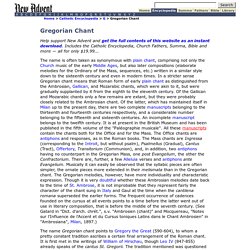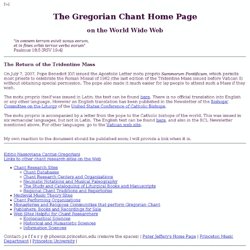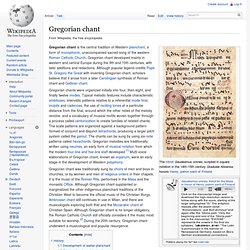

Gregorian Chant. Help support New Advent and get the full contents of this website as an instant download.

Includes the Catholic Encyclopedia, Church Fathers, Summa, Bible and more — all for only $19.99... The name is often taken as synonymous with plain chant, comprising not only the Church music of the early Middle Ages, but also later compositions (elaborate melodies for the Ordinary of the Mass, sequences, etc.) written in a similar style down to the sixteenth century and even in modern times. In a stricter sense Gregorian chant means that Roman form of early plain chant as distinguished from the Ambrosian, Gallican, and Mozarabic chants, which were akin to it, but were gradually supplanted by it from the eighth to the eleventh century. Of the Gallican and Mozarabic chants only a few remains are extant, but they were probably closely related to the Ambrosian chant.
The principal proofs for a Gregorian tradition may be summarized thus: Comments Sources About this page APA citation. MLA citation. Gregorian Chant Notation. Enigma – Electronic music meets Gregorian Chants. Enigma first caught my attention because of the Gregorian chants they integrated into their music, especially on their third album Le Roi est Mort, released in 1996.

But I have to admit that my favorite CD remains McMxc A.D. in which they succeeded in combining electronic music, electrical guitars and Gregorian chants! Rather than a band, Enigma is a musical project that mixed electronic music with traditional elements from the beginning. Imagine a time when the music world just got used to synthesizer beats! Image: Tony the Misfit When their first hit song “Sadeness (Part 1)” came out in 1990, it seemed like the world was stunned and enchanted at the same time.
What helped their success was the element of mystery that shrouded them like a true enigma. What also helped was German pop singer Sandra’s involvement in Enigma’s music. But back to Gregorian chants: As listeners of my music will know, I prefer wordless songs that let my imagination flow freely. Be Sociable, Share! Mac OS X Server. On the World Wide Web "in omnem terram exivit sonus eorum, et in fines orbis terrae verba eorum" Psalmus 18:5 [RSV 19:4] The Return of the Tridentine Mass On July 7, 2007, Pope Benedict XVI issued the Apostolic Letter motu proprio Summorum Pontificum , which permits most priests to celebrate the Roman Missal of 1962 (the last edition of the Tridentine Mass issued before Vatican II) without obtaining special permission.

The pope also made it much easier for lay people to attend such a Mass if they wish. The motu proprio itself was issued in Latin; the text can be found here . The motu proprio is accompanied by a letter from the pope to the Catholic bishops of the world. My own reaction to the document should be published soon; I will provide a link when it is. Editio Nassoviana Cantus Gregoriani Links to other chant research sites on the Web Contact: j e f f e r y @ phoenix.princeton.edu (remove the spaces) | Peter Jeffery's Home Page | Princeton Music Department | Princeton University | Italy.
Gregorian chant. Gregorian chant is the central tradition of Western plainchant, a form of monophonic, unaccompanied sacred song of the western Roman Catholic Church.

Gregorian chant developed mainly in western and central Europe during the 9th and 10th centuries, with later additions and redactions. Although popular legend credits Pope St. Gregory the Great with inventing Gregorian chant, scholars believe that it arose from a later Carolingian synthesis of Roman chant and Gallican chant. History[edit] Development of earlier plainchant[edit] Musical elements that would later be used in the Roman Rite began to appear in the 3rd century. Scholars are still debating how plainchant developed during the 5th through the 9th centuries, as information from this period is scarce.
John the Deacon, biographer (c. 872) of Pope Gregory I, modestly claimed that the saint "compiled a patchwork antiphonary",[11] unsurprisingly, given his considerable work with liturgical development. Origins of mature plainchant[edit]